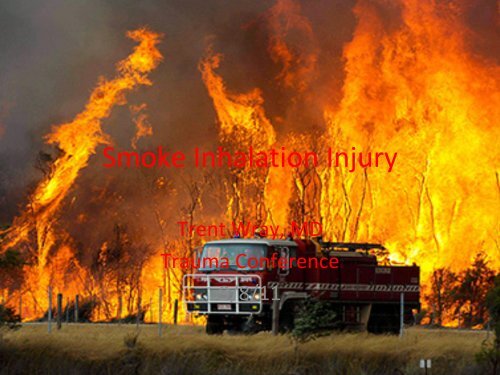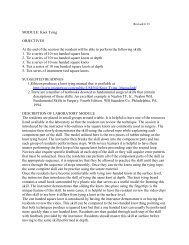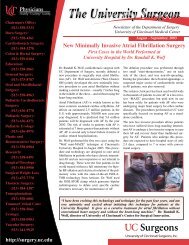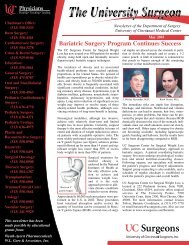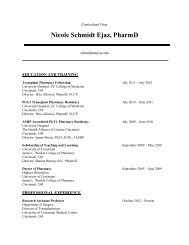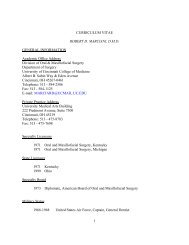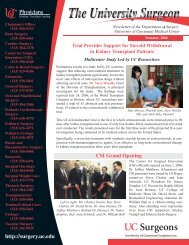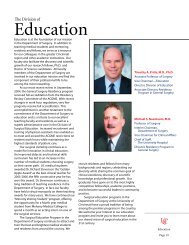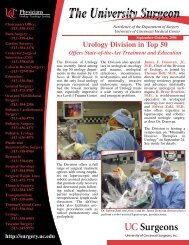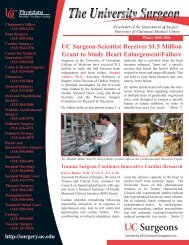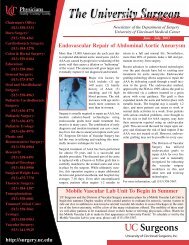Smoke Inhalation Injury - Surgery
Smoke Inhalation Injury - Surgery
Smoke Inhalation Injury - Surgery
Create successful ePaper yourself
Turn your PDF publications into a flip-book with our unique Google optimized e-Paper software.
<strong>Smoke</strong> <strong>Inhalation</strong> <strong>Injury</strong><br />
Trent Wray, MD<br />
Trauma Conference<br />
9/8/11
• Mel Otten<br />
• Chris Droege<br />
Thanks!
Objectives<br />
• Clinical Course of <strong>Inhalation</strong> <strong>Injury</strong><br />
• Complications of <strong>Inhalation</strong> <strong>Injury</strong><br />
• Treatment of <strong>Inhalation</strong> <strong>Injury</strong>
Non‐Objectives<br />
• Detailed lecture on CO or Cyanide<br />
• Burn resuscitation<br />
• Burn management<br />
• Detailed airway management
House Fire<br />
• 45 y/o male found at neighbor’s after house fire
House Fire<br />
• 45 y/o male found at neighbor’s after house fire<br />
• Per EMS:<br />
– Covered c ice/wrapped in blanket by neighbor.<br />
– c/o SOB, coughing.<br />
– Soot around mouth.<br />
– Does not remember event.<br />
– GCS 10 (3E, 2V, 5M)
House Fire<br />
• On Arrival:<br />
– Confused, groaning, GCS 10 (3E, 2V, 5M).<br />
– 96.0 R 128 161/100, 12<br />
– Gen:<br />
• No signs of trauma, numerous burns.<br />
• Soot noted on clothes, around mouth and face<br />
• Extending his neck (trying to control own airway)<br />
• No audible stridor<br />
• Labored breathing<br />
• Accessory muscle use noted
House Fire<br />
• On Arrival:<br />
– HEENT:<br />
• Partial‐Thickness facial burns – rubbery edema of eyes<br />
• Scalp burns extending toward neck<br />
• Obese neck, diminished neck extension<br />
• Very erythematous OP with soot noted in oropharynx<br />
– Chest/Abdomen:<br />
• No signs of trauma<br />
• Diminished breath sounds at bases<br />
• Very coarse breath sounds bilaterally<br />
• Partial and full thickness burns to chest, abdomen, and back<br />
• Obese Abdomen
House Fire<br />
• On Arrival:<br />
– Extremities:<br />
• Circumferential FT and PT burns to BLUE’s and BLLE’s.<br />
– Neuro:<br />
• GCS as above<br />
• CN II –XII grossly intact<br />
• Moves all extremities<br />
– Overall:<br />
• Burns to 46% TBSA<br />
• Concern for inhalation injury
ED Course<br />
• SaO2 92% on NRM, Soot in edematous airway,<br />
diminished GCS Intubate.
ED Course<br />
• Soot‐filled, edematous airway.<br />
• Chords too edematous to get 8.0 tube<br />
through<br />
• Repeat attempt with bougie + 6.5 tube <br />
successful.
• Initial Labs:<br />
– CBC: WBC 27<br />
– Renal Panel: AG 21<br />
ED Course<br />
– ABG: 7.16/46/64/16/‐13<br />
– Lactate: 8.9
• Course:<br />
ED Course<br />
– Placed on ARDSNET Vent Settings<br />
– Resuscitated using Parkland Formula<br />
• 4 X Kg X % TBSA Burned<br />
– Hydroxycobalamin given<br />
– Bronchoscopy Performed:
Hospital Course<br />
• HD 1:<br />
– Bronch: edema and soot noted in distal bronchi<br />
– Chest Tube (suspected PTx)<br />
• HD 3:<br />
– Trach; NJT Placement<br />
• HD 5:<br />
– Gets PNA<br />
• HD 12:<br />
– Excision of BLUE eschars + grafting<br />
• HD 15:<br />
– Excision of BL shoulder eschars + grafting<br />
• HD 19:<br />
– Trunk Eschars excised and grafted<br />
• HD 26 & 27:<br />
– Trunk and LE exchars excised and grafted<br />
• Currently on HD 35:<br />
– Trach + NJT continued.<br />
– Now waking and following commands<br />
– Ongoing grafting
• Epidemiology:<br />
<strong>Inhalation</strong> <strong>Injury</strong><br />
– “Fire Deaths” in 2011: 3,500 (3,000 res/500 auto)<br />
• U.S. Highest fire fatality rates in developed world.<br />
– 75% occurred at scene or during transport<br />
– Est 60‐80% deaths due to smoke inhalation<br />
– Correlates with % TBSA Burned:<br />
• < 5% TBSA = 10% <strong>Inhalation</strong> <strong>Injury</strong><br />
• > 85% TBSA = 80% <strong>Inhalation</strong> <strong>Injury</strong><br />
Sources:<br />
1.) ABA Fact Sheet<br />
2.) Muller et al 2001
• Epidemiology:<br />
– Mortality:<br />
• Burn Alone: 2%<br />
<strong>Inhalation</strong> <strong>Injury</strong><br />
• <strong>Inhalation</strong> <strong>Injury</strong> Alone: 7%<br />
• Both: 29%<br />
Source: Marshall et al 1998
• What is <strong>Smoke</strong>?<br />
<strong>Inhalation</strong> <strong>Injury</strong><br />
– Complete Combustion Rxn:<br />
• CH 4 + 2 O 2 → CO 2 + 2 H 2 O + energy<br />
– Incomplete Combustion Rxn (partial oxidation):<br />
• CH4 + O2 CO + H2O + 3H<br />
(insert misc product here)
• What is smoke?<br />
<strong>Inhalation</strong> <strong>Injury</strong><br />
– Products of combustion<br />
• Heat<br />
• Gases<br />
• Particles
<strong>Inhalation</strong> <strong>Injury</strong><br />
• What is smoke?<br />
– Gases:<br />
• CN/HCN<br />
• CO<br />
• Other Nitrates<br />
– Particles:<br />
• Water Soluble:<br />
– SO2, HCl, NH3, Propenal (Acrolein)<br />
• Non‐Water Soluble:<br />
– NO, NO2, N2O, Polyvinylchloride (PVC)
<strong>Inhalation</strong> <strong>Injury</strong><br />
• Mechanisms of <strong>Smoke</strong> <strong>Inhalation</strong> <strong>Injury</strong>:<br />
– Thermal Damage<br />
– Asphyxiation<br />
– Pulmonary Irritation
<strong>Inhalation</strong> <strong>Injury</strong><br />
• Direct Thermal <strong>Injury</strong> (heated gases):<br />
– Usually upper airway:<br />
• Inhaled air doesn’t conduct heat well<br />
• Glottic reflex<br />
• Why laryngoscopy is usually recommended before<br />
bronchoscopy<br />
– Unless it’s steam/liquid:<br />
• Heat carrying capacity ~ 4,000 X air<br />
• May cause pan‐airway damage edema<br />
• May perform bronchoscopy prior to laryngoscopy
• Asphyxia:<br />
<strong>Inhalation</strong> <strong>Injury</strong><br />
– Low environmental FIO2<br />
– CN<br />
– CO<br />
– Methemglobinemia
• Asphyxia:<br />
<strong>Inhalation</strong> <strong>Injury</strong><br />
– Low environmental FIO2:<br />
• O2 consumed in combustion reactions (see above)<br />
• Pull them out and place on 100% O2
• Asphyxia:<br />
– Cyanide (HCN, CN):<br />
<strong>Inhalation</strong> <strong>Injury</strong><br />
• Present in nearly all structure fires<br />
– Wool, Rubber, PVC, Paper, foods<br />
– Colorless, Almond odor<br />
• Present in up to 35% of all fire victims<br />
• In one plane fire, 90% had CN toxicity (20% had CO)<br />
Source: Walsh DW, Eckstein M (2004)
<strong>Inhalation</strong> <strong>Injury</strong><br />
• Asphyxia:<br />
– Cyanide (HCN, CN):<br />
• 20X more toxic than CO<br />
• Binds to Fe2+ Cyanohemoglobin:<br />
– Hypoxia<br />
• Binds to Fe3+ on Cytochrome a3 disrupts ETC<br />
– Shift toward Anaerobic Metabolism and uncoupling:<br />
» Cannot use O2 Venous blood turns bright red<br />
» Lactic Acidosis<br />
» H+ production Decreased HCO3‐<br />
• Particularly affects CV and Brain (Basal Ganglia)
<strong>Inhalation</strong> <strong>Injury</strong><br />
• Asphyxia:<br />
– Cyanide (HCN, CN):<br />
• Metabolized by Rhodanese enzyme Kidney<br />
– Thiosulfate is sulfur donor<br />
• Bound by Vitamin B12 (Hydroxycobolamin)<br />
• S&S:<br />
– “Sick and Cherry Red”<br />
– Most patients who are sick after a house fire<br />
• Treatment:<br />
– Hydroxycobalamin 5 g IV (Cyanokit)<br />
– 25% Sodium Thiosulfate 1.65 cc/kg IV<br />
– NO EMPIRIC NITRITES<br />
Source: Barron et al (2007); Morocco (2005)
• Asphyxia:<br />
– CO:<br />
<strong>Inhalation</strong> <strong>Injury</strong><br />
• Responsible for most fire deaths<br />
• Leading cause of poisoning worldwide<br />
• Carbon + incomplete O2 combustion rxn<br />
• Binds to Hb with 200X greater affinity<br />
• Also binds myoglobin, cytochrome a3<br />
• Lipid Peroxidation Neuron demyelination<br />
Source: Kao LW et al (2006)
• Asphyxia:<br />
– CO:<br />
<strong>Inhalation</strong> <strong>Injury</strong><br />
Source: Demling (2008)
• Asphyxia:<br />
– CO:<br />
• Removal:<br />
<strong>Inhalation</strong> <strong>Injury</strong><br />
– t1/2 300 min on RA.<br />
– t1/2 90 min on 15L NRM<br />
• Consider HBO<br />
– Primarily decreases neurological sequelae<br />
– Particularly useful in pts with MI, Pregnant Women, Children<br />
– May be limited by injuries<br />
Source: Weaver et al (2002)
• Asphyxia:<br />
– Methemglobinemia:<br />
• Due to:<br />
<strong>Inhalation</strong> <strong>Injury</strong><br />
– low O2 environment<br />
– Nitrite inhalation<br />
– Fairly rare<br />
– Treat with Methylene Blue (1‐2 mg/kg IV over 5 min)<br />
» Causes cyanosis<br />
» Watch for rebound methemoglobinemia<br />
Source: Howland, Goldfrank (2006)
• Pulmonary Irritation:<br />
<strong>Inhalation</strong> <strong>Injury</strong><br />
– Airway Edema + Bronchoconstriction:<br />
• Particle stimulation of neuropeptides<br />
• Increase of transudate exudate<br />
• Racemic Epi, Bronchodilators<br />
– Damage to/Sloughing of endothelium:<br />
– Increased necrotic tissue + trapping of mucociliary clearance<br />
– May not be evident until after a 24‐48 hr “Honeymoon”<br />
– May Lead to Delayed PNA, ALI/ARDS
• Pulmonary Irritation:<br />
<strong>Inhalation</strong> <strong>Injury</strong><br />
– Damage to/Sloughing of endothelium:<br />
– Increased necrotic tissue + trapping of mucociliary clearance<br />
– May not be evident until after a 24‐48 hr “Honeymoon”<br />
– May Lead to Delayed PNA, ALI/ARDS<br />
– Early (and repeat?) bronchoscopy recommended<br />
Source: .<br />
Marek et al (2007)
<strong>Inhalation</strong> <strong>Injury</strong><br />
• Pulmonary Irritation:<br />
– Laryngoscopy to diagnose upper airway edema<br />
• If present, consider intubating<br />
– Bronchoscopy to diagnose lower airway edema<br />
• Soot<br />
• Mucosal Pallor<br />
• Mucosal Ulceration<br />
• Mucosal Erythema<br />
*If any of the above present = + Bronchoscopy<br />
‐Negative does not rule out inhalation injury
• Management:<br />
– 100% O2<br />
– Coximetry<br />
<strong>Inhalation</strong> <strong>Injury</strong><br />
– CBC, Renal, ABG/VBG, Lactate<br />
– Concern for cyanide Hydroxycobalamin<br />
– Concern for CO <br />
– Methemoglobinemia (> 30%) Methylene Blue
• Management:<br />
<strong>Inhalation</strong> <strong>Injury</strong><br />
– Consider early intubation if:<br />
• Any evidence of respiratory distress<br />
• Deep burns to the face/neck<br />
– If not, oropharyngeal exam:<br />
• Erythema, hoarseness Laryngoscopic exam<br />
– + edema INTUBATE Lung Protective Ventilation<br />
• No erythema, no hoarseness, stable pulm exam<br />
– follow closely (repeat exams)<br />
Source: Plurad et al (2007)
• Management:<br />
– Once Intubated:<br />
• ARDSNET Proocol<br />
<strong>Inhalation</strong> <strong>Injury</strong><br />
• Repeat Bronchoscopies?<br />
• Watch fluid resuscitation.<br />
• Vigilance for AKI/ARDS, PNA.<br />
• No role for prophylactic antibiotics or corticosteroids<br />
– Manage Burns<br />
Source: Plurad et al (2007)
<strong>Inhalation</strong> <strong>Injury</strong><br />
• Most common cause of “Fire Deaths”<br />
• Aggressive airway management<br />
• Watch for physical and chemical asphyxia<br />
– HCN, CO, MetHb<br />
• Vigilance for rapidly worsening respiratory<br />
status
Questions?
References<br />
• Borron SW, Baud FJ, Barriot P, Imbert M, Bismuth C. Prospective study of hydroxocobalamin for acute cyanide poisoning in<br />
smoke inhalation”. Ann Emerg Med. 2007;49(6):794<br />
• Carr JA, Phillips BD, Bowling WM (2009). “The utility of bronchoscopy after inhalation injury complicated by pneumonia in<br />
burn patients: results from the National Burn Repository.” J Burn Res Care. 2009 Nov‐Dec;30(6):967‐74.<br />
• Demling, RH. “<strong>Smoke</strong> <strong>Inhalation</strong> Lung <strong>Injury</strong>: An Update”. Eplasty. 2008;8:e27<br />
• Howland MA. Methylene blue. In: Goldfrank's Toxicologic Emergencies. 8 th ed. 2006:1746‐1748.<br />
• Kao LW, Nanagas KA. Toxicity associated with carbon monoxide. Clin Lab Med. Mar 2006;26(1):99‐12<br />
• . Marek K, Piotr W, Stanislaw S, et al. Fibreoptic bronchoscopy in routine clinical practice in confirming the diagnosis and<br />
treatment of inhalation burns. Burns. 2007;33(5):554–560<br />
• Marshall SW, Runyan CW, Bangdiwala SI, Linzer MA, Sacks JJ, Butts JD. “Fatal residential fires: who dies and who survives?”.<br />
JAMA. May 27 1998;279(20):1633‐7<br />
• Morocco AP. “Cyanides”. Crit Care Clin. 2005;21(4):691<br />
• Muller MJ, Pegg SP, Rule MR. Determinants of death following burn injury. Br J Surg. Apr 2001;88(4):583‐7.<br />
• Plurad D, Martin M, Green D, et al. The decreasing incidence of late posttraumatic acute respiratory distress syndrome: the<br />
potential role of lung protective ventilation and conservative transfusion practice. J Trauma. 2007;63(1):1–7. discussion<br />
• Sauer SW, Keim ME. “Hydroxocobalamin: improved public health readiness for cyanide disasters” . Ann Emerg Med.<br />
2001;37(6):635.<br />
• Walsh DW, Eckstein M.”Hydrogen Cyanide in Fire <strong>Smoke</strong>: an Underappreciated Threat.” Emerg Med Serv. 2004;33(10):160<br />
• Weaver LK, Hopkins RO, Chan KJ, et al. Hyperbaric oxygen for acute carbon monoxide poisoning. N Engl J Med. Oct 3<br />
2002;347(14):1057‐67


